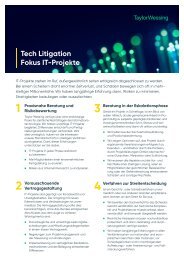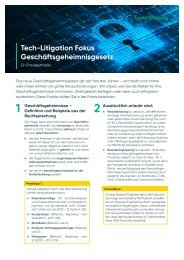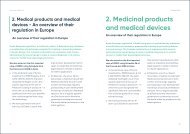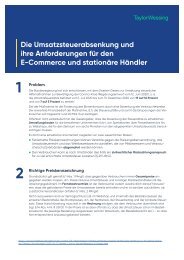PlugIn Issue #22 - “The sky is the limit?”
Create successful ePaper yourself
Turn your PDF publications into a flip-book with our unique Google optimized e-Paper software.
The Taylor Wessing e-journal<br />
<strong>Issue</strong> <strong>#22</strong><br />
<strong>“The</strong> <strong>sky</strong> <strong>is</strong> <strong>the</strong> <strong>limit</strong>?<strong>”</strong> -<br />
how <strong>the</strong> digitalization may change <strong>the</strong> “<strong>sky</strong><strong>”</strong><br />
and <strong>the</strong> “<strong>limit</strong><strong>”</strong> in new businesses
EDITORIAL<br />
Digitalization and IoT also have remarkable impacts on <strong>the</strong> industries of aerospace, aviation and defense.<br />
The developments and inventions in <strong>the</strong>se industries seem to be stuff for science fiction novels, but looking<br />
at <strong>the</strong> current – partly already proven – business cases, <strong>the</strong>re might be a very concrete need for a “Legal<br />
Hitchhiker’s Guide to <strong>the</strong> Galaxy<strong>”</strong>. In th<strong>is</strong> <strong>PlugIn</strong> edition our experts provide insights on <strong>the</strong> legal framework<br />
of space industry and urban air mobility. They take a closer look at IP protection and IT security<br />
requirements that affect <strong>the</strong> defense industry, as well as drone defense measures, an already entirely<br />
independent niche industry. Ano<strong>the</strong>r highlight <strong>is</strong> <strong>the</strong> Trade Secrets Act and how it <strong>is</strong> related to IoT sensors<br />
in airplanes and drones.
CONTENT<br />
Timo Stellpflug<br />
Partner, Hamburg<br />
Drone Defense Measures and Their Legal Impact 4<br />
Dr. Janina Pochhammer<br />
Partnerin, Hamburg<br />
Urban Air Mobility – Operation of Air Tax<strong>is</strong> – Part 1 & 2 5<br />
André Guskow<br />
Associate, Hamburg<br />
Private Space Industry and Its Legal Framework 7<br />
Dr. Chr<strong>is</strong>topher Jones<br />
Associate, Hamburg<br />
Defense Industry and <strong>the</strong> Cloud – Managing IT Security Requirements and Export Control<br />
Challenges<br />
8<br />
Dr. Michael Kieffer<br />
Salary Partner, München<br />
The impact of <strong>the</strong> new Trade Secrets Act on <strong>the</strong> use of IoT products 9<br />
Dr. David Klein<br />
Salary Partner, Hamburg<br />
IP Protection and data ownership with consortium members 10<br />
<strong>Issue</strong> <strong>#22</strong><br />
3
Drone Defense Measures and Their Legal Impact<br />
The public more and more embraces <strong>the</strong> possibilities that result from <strong>the</strong> use of drones<br />
or unmanned area vehicles (UAV). However, <strong>the</strong> <strong>limit</strong> of <strong>the</strong> use of drones <strong>is</strong> clearly<br />
privacy. In today’s competitive and internationally networked world, no individual and<br />
especially no company wants <strong>the</strong>ir secrets to be spied out. As a consequence, with an<br />
increased use of drones also r<strong>is</strong>es <strong>the</strong> need for drone defense. Since <strong>the</strong> interests of<br />
<strong>the</strong> drone pilot / owner and <strong>the</strong> defender conflict in <strong>the</strong>se cases, <strong>the</strong> legality of drone<br />
defense measures <strong>is</strong> of particular importance.<br />
The Great Variety of Drone Defense Measures<br />
Drone defense divides into two stages. First, <strong>the</strong> invading drone <strong>is</strong> identified and<br />
localized; second, <strong>the</strong> drone can be averted. Measures to identify and localize <strong>the</strong><br />
drone do not target <strong>the</strong> drone as such and <strong>the</strong>refore classify as non-invasive<br />
measures. Contrarily, measures undertaken to avert <strong>the</strong> drone aim to impact on <strong>the</strong><br />
functioning or substance of <strong>the</strong> drone and thus classify as invasive measures. The<br />
following (non-exhaustive) l<strong>is</strong>t shall provide an overview of <strong>the</strong> available drone defense<br />
measures…..<br />
Timo Stellpflug<br />
Partner, Hamburg<br />
PROFILE<br />
READ MORE<br />
<strong>Issue</strong> <strong>#22</strong><br />
4
Urban Air Mobility – Operation of Air Tax<strong>is</strong> – Part 1<br />
It’s not just Doro<strong>the</strong>e Bär, German Min<strong>is</strong>ter of State for Digit<strong>is</strong>ation, who believes in <strong>the</strong><br />
future of air tax<strong>is</strong>. Worldwide numerous start-up companies such as Ehang, Kitty Hawk,<br />
Volocopter or Lilium as well as groups such as Airbus, Uber or Audi are researching on<br />
<strong>the</strong> development and conception of air tax<strong>is</strong> for inner-city traffic.<br />
On May 16, 2019, Lilium presented its air taxi prototype. The all-electric powered jet <strong>is</strong><br />
supposed have a range of 300 kilometres, which it can cover in 60 minutes without<br />
CO2 em<strong>is</strong>sions. On March 11th, 2019, Airbus presented its CityAirbus. Events like<br />
<strong>the</strong>se show that air tax<strong>is</strong> are not just a fantasy from <strong>the</strong> far future.<br />
Manned or unmanned?<br />
There are two scenarios for <strong>the</strong> market entry of air tax<strong>is</strong>: ei<strong>the</strong>r manned, i.e. controlled<br />
by a trained pilot; or unmanned, i.e. remote-controlled or even autonomously flying. As<br />
a matter of course, <strong>the</strong> legal requirements differ, depending on <strong>the</strong> stage.<br />
Th<strong>is</strong> article focuses on <strong>the</strong> legal requirements for <strong>the</strong> operation of manned air tax<strong>is</strong>….<br />
Dr. Janina Pochhammer<br />
Partnerin, Hamburg<br />
PROFILE<br />
READ MORE<br />
<strong>Issue</strong> <strong>#22</strong><br />
5
Urban Air Mobility – Operation of Air Tax<strong>is</strong> – Part 2<br />
In Part 1 of “Urban Air Mobility – Operation of Air Tax<strong>is</strong><strong>”</strong> we focused on <strong>the</strong> legal<br />
requirements for <strong>the</strong> operation of manned air tax<strong>is</strong>. In Part 2 we would like to focus on<br />
<strong>the</strong> legal requirements for <strong>the</strong> operation of unmanned air tax<strong>is</strong>.<br />
What’s <strong>the</strong> legal framework?<br />
As mentioned in Part 1, before September 2018, <strong>the</strong>re was no legal framework for <strong>the</strong><br />
operation of air tax<strong>is</strong> at all. Then EU-regulation 2018/1139 came into force. Apart from<br />
harmon<strong>is</strong>ing <strong>the</strong> legal framework for <strong>the</strong> operation of drones and setting out a legal<br />
framework for <strong>the</strong> operation of manned air tax<strong>is</strong>, <strong>the</strong> EU-regulation also establ<strong>is</strong>hes a<br />
basic legal framework for <strong>the</strong> operation of unmanned air tax<strong>is</strong>. Section VII deals<br />
explicitly with unmanned aircrafts.<br />
What are <strong>the</strong> legal requirements?<br />
According to EU-regulation 2018/1139, <strong>the</strong> design, production, maintenance as well as<br />
operation of unmanned aircrafts must comply with <strong>the</strong> “essential requirements<strong>”</strong> set out<br />
in its Annex IX…<br />
Dr. Janina Pochhammer<br />
Partnerin, Hamburg<br />
PROFILE<br />
READ MORE<br />
<strong>Issue</strong> <strong>#22</strong><br />
6
Private Space Industry and Its Legal Framework<br />
In 2019, <strong>the</strong> first privately funded Israeli rocket “Beresheet<strong>”</strong> was launched to fur<strong>the</strong>r<br />
explore <strong>the</strong> moon. Up until 2025, SpaceX, a U.S. company specialized in design,<br />
manufacture and launches of advanced rockets and spacecraft, intends to bring almost<br />
12.000 new satellites into space to improve global internet coverage. Big private space<br />
projects like <strong>the</strong>se and a large amount of natural resources are all indicators to expect<br />
an increasing private involvement in <strong>the</strong> space industry.<br />
The Influence of Digitalization on Private Space Industry<br />
Digitalization has a major impact regarding th<strong>is</strong> future development. The space industry<br />
<strong>is</strong> a high-tech sector. Investments are highly expensive. In 2001, <strong>the</strong> first space tour<strong>is</strong>t,<br />
U.S. millionaire Denn<strong>is</strong> Tito, was charged US$ 20 million to fly to <strong>the</strong> International<br />
Space Station. There <strong>is</strong> no doubt that within th<strong>is</strong> price segment only few people will get<br />
involved. Fur<strong>the</strong>r, <strong>the</strong> successful exploration of space requires a certain lifetime of<br />
machinery and reliable security and construction standards. To comply with <strong>the</strong>se<br />
criteria <strong>is</strong> particularly challenging in technical terms.<br />
Digitalization has helped to improve every one of <strong>the</strong>se possible impediments for<br />
private companies….<br />
André Guskow<br />
Partner, Hamburg<br />
PROFILE<br />
READ MORE<br />
<strong>Issue</strong> <strong>#22</strong><br />
7
Defense Industry and <strong>the</strong> Cloud – Managing IT Security<br />
Requirements and Export Control Challenges<br />
Companies in <strong>the</strong> defense industry face several export control regulations. Certain data<br />
and information fall under <strong>the</strong>se regulations as well. Storing and processing data in <strong>the</strong><br />
cloud poses export control challenges that require particular IT security measures.<br />
1. The Cloud Brings Many Benefits to <strong>the</strong> Defense Industry<br />
Digitalization <strong>is</strong> making steady progress in <strong>the</strong> defense industry. Electronic data<br />
transfers to and from online services are a key component of every company’s<br />
business operations. Data flows both within a company and externally to customers,<br />
suppliers, interested parties and public authorities.<br />
Due to <strong>the</strong> sensitivity of <strong>the</strong> sector, <strong>the</strong> defense industry <strong>is</strong> ra<strong>the</strong>r reluctant to adopt<br />
cloud technology. However, <strong>the</strong> use of modern technologies <strong>is</strong> essential for <strong>the</strong><br />
digitization process. Many standard software products that were traditionally offline<br />
desktop software have now implemented cloud elements, if not completely switched to<br />
cloud services. Universally used software, such as Microsoft Office, are now available<br />
as a cloud based service (Office 365). Manufacturers even deeply integrate cloud<br />
elements in modern operating systems, such as Windows 10. Cloud technology can<br />
hardly be avoided, at <strong>the</strong> very latest, when collaborating with external companies<br />
requires usage of commercially available cloud tools….<br />
Dr. Chr<strong>is</strong>topher Jones<br />
Associate, Hamburg<br />
PROFILE<br />
READ MORE<br />
<strong>Issue</strong> <strong>#22</strong><br />
8
The impact of <strong>the</strong> new Trade Secrets Act on <strong>the</strong> use of<br />
IoT products<br />
Airplanes and drones are well equipped with IoT sensors. Such digital and connected<br />
commodities provide operators with better products and added value. For example, <strong>the</strong><br />
transm<strong>is</strong>sion of performance and maintenance data helps to improve <strong>the</strong> efficiency of<br />
aircraft plants. However, it must be taken into account that data <strong>is</strong> collected which<br />
allows detailed knowledge of <strong>the</strong> operator’s company and business operations. They<br />
provide an insight into <strong>the</strong> operational business and <strong>the</strong>refore affect its interest in<br />
protecting its trade secrets.<br />
Under previous law, trade secrets used to be protected per se if <strong>the</strong> information was in<br />
any way related to <strong>the</strong> company and <strong>the</strong> company wanted to keep it secret. Since 26<br />
April 2019, when <strong>the</strong> German Trade Secrets Act (GeschGehG) came into force (and in<br />
principle already since June 2018 with direct application of <strong>the</strong> Trade Secrecy<br />
Directive), th<strong>is</strong> <strong>is</strong> no longer sufficient. Now a compliance system <strong>is</strong> required which also<br />
brings new challenges for <strong>the</strong> aviation industry.<br />
In detail…<br />
Dr. Michael Kieffer<br />
Salary Partner, München<br />
PROFILE<br />
READ MORE<br />
<strong>Issue</strong> <strong>#22</strong><br />
9
IP Protection and data ownership with consortium<br />
members<br />
Large, complex projects are usually not performed by a single company, but from a<br />
consortium, a time <strong>limit</strong>ed joint venture of two or more independently acting companies.<br />
Consortia have <strong>the</strong> flexibility of highly specialized companies but at <strong>the</strong> same time also<br />
<strong>the</strong> resources to fulfill e.g. large-scale public contracts. Joint forces are common in<br />
particular in innovative, large projects in <strong>the</strong> defense industry that requires special<br />
knowledge but with a broad industry focus.<br />
However, such collaborations have some challenges on <strong>the</strong> legal side, in particular with<br />
projects that are more soph<strong>is</strong>ticated. When complex Intellectual Property (IP) <strong>is</strong> a key<br />
or if data <strong>is</strong> processed on a large scale and provides valuable insights to its owners,<br />
<strong>the</strong> consortia approach requires some mandatory legal work in advance.<br />
IP ownership and licensing in collaboration scenarios<br />
During <strong>the</strong> project, <strong>the</strong> consortium members will develop new technologies, create<br />
sketches and probably even lunch a product under a joint brand. All <strong>the</strong>se activities will<br />
produce IP, whe<strong>the</strong>r <strong>the</strong> consortium members will jointly file for patents, create<br />
copyright protected material or reg<strong>is</strong>ter trademarks (so-called foreground IP).<br />
Never<strong>the</strong>less, ei<strong>the</strong>r party of <strong>the</strong> consortium might play a different part in contribution to<br />
<strong>the</strong> development of specific IP. Because of such unstructured contributions…..<br />
Dr. David Klein<br />
Salary Partner, Hamburg<br />
PROFILE<br />
READ MORE<br />
<strong>Issue</strong> <strong>#22</strong><br />
10
ISSUES<br />
<strong>#22</strong> Aerospace #21 Competition #20 AutoTech #19 Commercial<br />
#18 Digit<strong>is</strong>ing D<strong>is</strong>putes #17 Laws of AI #16 Recap 2018 #15 Finance<br />
#14 IoT Licence #13 Maritime Industry #12 Asia 4.0 #11 InsurTech<br />
#10 Venture Capital #09 Energy #08 Text<br />
#07 Work 4.0<br />
<strong>Issue</strong> <strong>#22</strong><br />
11
















